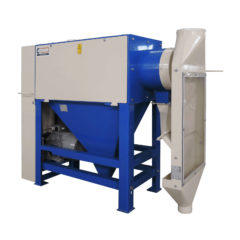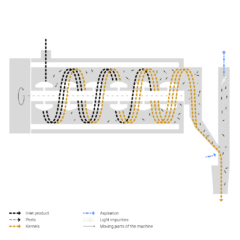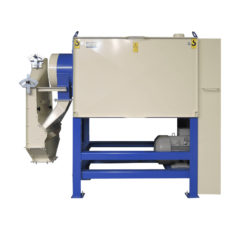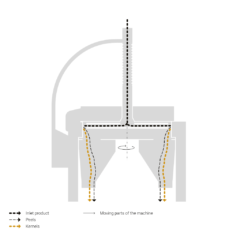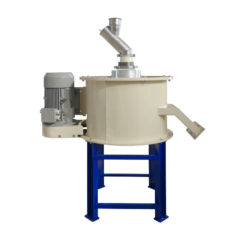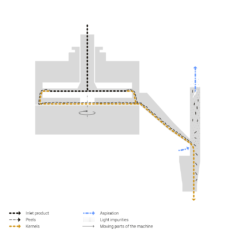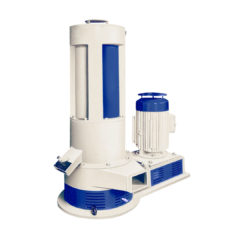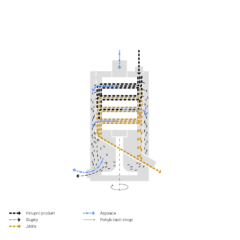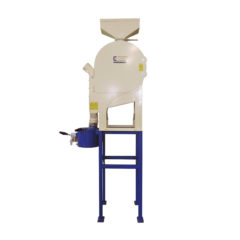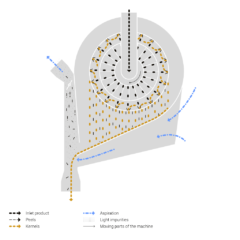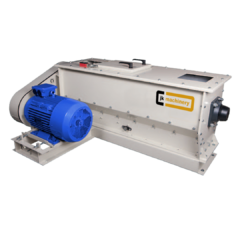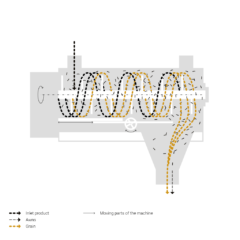How Dehulling Lines work
Intensive peeling and scouring of the grain is a process to increase the value of the grain. The purpose is to remove the husk and possibly the outer layers of the grain. It is possible to dehull by peeling, with knives, impact dehulling or with the help of other technologies using heat, water, chemicals, etc.
The reason for acquiring dehulling technology is a direct increase in the added value of the commodity, and thus achieving a higher selling price of the final product. Another reason is to include this technology before further processing of the commodity in the food or feed production line. An example is the use of dehulling in an oatmeal production line or in an oil pressing line, where peeling can affect both the quality of the oil itself and in particular the quality of the press cake, which are an important raw material for further feed processing.
Peeled crops can be cereals, oilseeds, legumes, but also other technical or exotic crops.
The basic Dehullers include:
– Horizontal Peeling Machine JHP
– Horizontal Scourer JHS
– Impact Dehuller JHI
– Disc Dehuller JHD
– Vertical Dehuller JHV
– Compact Dehuller JHC
– De-awner JHA
Horizontal Peeling Machines
JHP Horizontal Peeling Machines are designed for surface cleaning and peeling cereals and legumes before further procesing. They are used for intensive peeling of outer layers of grains, eg rye before grinding in rye mills, removal of oat awns before flocculation, etc. The peeling element is a stone to which the material is directed by the driving blades. Output at the end (usually into aspiration box) drops a mixture of grains and husks. Horizontal Peeling machines are intended for peeling the following commodities: rye, oats, spelt, einkorn wheat, emmer wheat, peas, lentils and more.
Horizontal Scourer
JHS Horizontal Scourers are designed for surface cleaning and peeling cereals and legumes before further procesing. The scouring element is made of perforated metal sheet, to which the material is directed by the drive blades. Output at the end (usually into aspiration box) drops a mixture of grains and husks. Through output under scouring element (collecting hopper) fall husks and fragments. JHS Horizontal Scourers are used for surface cleaning of wheat. In doing so, part of the outer layers of the grain and the awns are removed. Furthermore, they can be used for de-awning of barley, cumin, spelt, rice (paddy) or for surface cleaning and polishing of cereals and legumes in general.
Impact Dehullers
JHI Impact Dehullers are used for dehulling of oilseeds or cereals where the core is not firmly attached to the husk. Dehulling uses kinetic energy of impact of moving seed. JHI dehullers are used for dehulling raw materials that have already been cleaned and sorted (calibrated). After dehulling, it is necessary to sort husks, fragments of kernels, whole kernels and unpeeled grains. The machine is not suitable for peeling seeds, where the husk is firmly attached to the kernel.
Impact Dehullers are intended for peeling oilseeds, eg sunflowers, hemp, moringa, pine nuts, cherry stones, as well as for peeling cereals, eg oats, spelt, einkorn and emmer wheat. Peeled raw material is most often used for direct consumption of whole kernels, or other food or feed operations may be included.
Disc Dehuller
JHD Disc Dehullers are used to separate seed husks which are not firmly attached to the kernel.
Peeling takes place in the gap between the rotating and the standing disc. The material enters through a hole in the center of the disc and exits around the perimeter. It is possible to use different combinations of dehulling discs – eg steel, rubber, corundum. The rotating disc is mounted in roller bearings with high load capacity. The non-rotating disc is vertically adjustable. By approaching or moving away from the rotating disk, the size of the peeling gap changes, ie the gap between the two disks. The surface of the rotor and stator varies depending on type of peeled material. The setting of the optimal peeling gap between the rotor and the stator depends on the grain size. Peeled material must be dosed into the disc dehuller equally. Raw material to be peeled must be very well cleaned, and free of stones, which can damage the hulling pads and seeds must be sorted according to size (calibrated). Disc dehullers are designed especially for peeling buckwheat and millet.
Vertical Dehuller
JHV Vertical Dehullers are used for intensive peeling of cereals and legumes. The peeling of the product takes place in the space between the vertical grinding wheels mounted on the hollow shaft and the circular screen. Air passes through the hollow shaft, which cools the peeled product. Capacity and peeling intensity is adjusted on the output of the machine. The machine must be connected to an external aspiration that continuously removes peeled material. Vertical Dehullers are designed for peeling barley in the production of groats, as well as for peeling lentils, wheat, rye, sorghum, peas, rice, etc.
Compact Dehuller
JHC Compact Dehullers work on the horizontal principle. The peeled material is fed into a rotating rotor, which accelerates the peeled grains and directs them against a special impact disc made of abrasion-resistant plastic, by which the outer shell of the grain is broken by impact. This method of peeling is efficient and low energy consumption. JHC dehullers are designed for peeling cereals, especially spelt, einkorn and emmer wheat, and oats.
De-awner
JHA de-awners are designed for de-awnering and seed treatment before cleaning. The machine consists of a steel case in which a rotating shaft with steel fingers is placed. By moving these fingers the process of crushing, deawnering and smoothing the grain takes place inside the case. Capacity and intensity of the material treatment is set by the slide in the output.
When installing the JHA de-awner as a single machine, it is recommended to consider the aspiration on the machine output. When installing the machine at the input of the JCM VibroMAX modular cleaner, it is recommended to install a bypass for cleaning without de-awnering.
JHA de-awner are designed for deawnering barley, wheat, oat and comminuting bunches of seeds.

